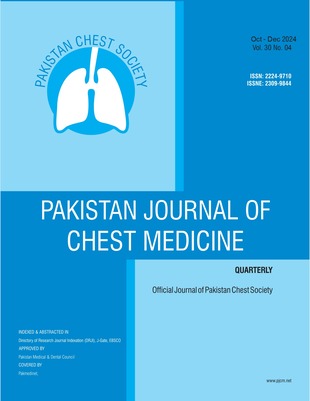Predictive value of D-Dimer levels for Pulmonary Thromboembolism at initial COVID-19 Diagnosis: Experience from a Tertiary Care Hospital
Keywords:
D-Dimer, COVID-19, Pulmonary ThromboembolismAbstract
Background: Coronavirus disease 2019 (COVID-19) carries a higher risk of thromboembolic complications, especially pulmonary thromboembolism (PTE). Identifying PTE early is important but can be hard because of similar respiratory symptoms. D-dimer, a common biomarker, may help predict thrombotic risk. Still, experts do not know the best cutoff level for D-dimer in COVID-19 patients. Objective: This study aims to find out how often pulmonary thromboembolism (PTE) occurs at the time of COVID-19 diagnosis and to see how D-dimer levels relate to patients with COVID-19. Methodology: This retrospective study included 240 confirmed COVID-19 patients who had CT pulmonary angiography (CTPA) when they were admitted to the hospital for suspected pulmonary thromboembolism (PTE). We collected and analyzed admission D-dimer levels and clinical data. Patients were divided into groups based on whether they had PTE or not. We used receiver operating characteristic (ROC) analysis to find the best D-dimer cutoff value for predicting PTE. Results: PTE was found in 32 out of 240 patients (13.3%) using CTPA. Median D-dimer levels were significantly higher in patients with PTE compared to those without (1680 ng/mL vs 980 ng/mL, p<0.001). ROC analysis showed an area under the curve (AUC) of 0.667, and a D-dimer cutoff of 1000 ng/mL gave the best diagnostic performance. Age and male gender also emerged as independent predictors of PTE. Conclusion: D-dimer is a helpful predictor of pulmonary thromboembolism in COVID-19 patients at the time of hospital admission. A cutoff of 1000 ng/mL provides a practical balance between sensitivity and specificity. Age and being male further raise the risk of PTE. Early assessment with D-dimer could help with timely diagnosis and management.References
Kwee RM, Adams HJ, Kwee TC. Frequency of pulmonary embolism and D dimer levels in COVID 19: systematic review and meta analysis. Eur Radiol. 2021;31:9393–9401. DOI: 10.1007/s00330-021-08003-8.
Asakura H, Ogawa H. COVID 19 associated coagulopathy and disseminated intravascular coagulation. Int J Hematol. 2020;112:553–560. DOI:10.1007/s12185-020-02906-w.
Chassagnon G, El Hajjam M, Boussouar S, Revel MP, Khoury R, Ghaye B, et al. Strategies to safely rule out PE in COVID 19: pooled incidence. Eur Radiol. 2023;33. DOI:10.1007/s00330-023-09475-6.
Engels SY, van Veen IH, Oudkerk M, van der Palen J, Heuvelmans MA. An optimized D dimer cut off value to predict pulmonary thromboembolism in COVID 19 patients. J Thorac Dis. 2023;15(11):6317–6322. DOI:10.21037/jtd-23-870.
Gul MH, Htun ZM, de Jesus Perez V, Suleman M, Arshad S, Imran M. Predictors and outcomes of acute pulmonary embolism in COVID 19: a national cohort analysis. Respir Res. 2023;24:369. DOI:10.1186/s12931-023-02369-7.
Khanam S, Azam M, Hidayat U. Level and relation of D-dimer with COVID-19 patients disease outcome: A study from Khyber Pakhtunkhwa. Pak J Chest Med. 2021;27(4):254-61.
Beidollahkhani S, Fayedeh F, Shoja A, Hassan Nejad E, Hoseinpour M, Fazlpour F, et al. D dimer as a biomarker for COVID 19 associated pulmonary embolism. Egypt J Bronchol. 2023;17:21. DOI:10.1186/s43168-023-00221-6.
Thoreau B, Galland J, Delrue M, Neuwirth M, Stepanian A, Chauvin A, et al. D-Dimer level and neutrophils count as predictive and prognostic factors of pulmonary embolism in severe non-ICU COVID-19 patients. Viruses. 2021;13(5):758. DOI: 10.3390/v13050758.
Jevnikar M, Sanchez O, Chocron R, Andronikof M, Raphael M, Meyrignac O, et al. Prevalence of pulmonary embolism in patients with COVID-19 at the time of hospital admission. Eur Respir J. 2021;58(1):2100116. DOI: 10.1183/13993003.00116-2021.
Al-Ani F, Chehade S, Lazo-Langner A. Thrombosis risk associated with COVID-19 infection. A scoping review. Thromb Res. 2020;192:152–160. DOI: 10.1016/j.thromres.2020.05.039.
Lodigiani C, Iapichino G, Carenzo L, Cecconi M, Ferrazzi P, Sebastian T, et al. Venous and arterial thromboembolic complications in COVID-19 patients admitted to an academic hospital in Milan, Italy. Thromb Res. 2020;191:9–14. DOI: 10.1016/j.thromres.2020.04.024.
Tang N, Bai H, Chen X, Gong J, Li D, Sun Z. Anticoagulant treatment is associated with decreased mortality in severe coronavirus disease 2019 patients with coagulopathy. J Thromb Haemost. 2020;18(5):1094–1099. DOI: 10.1111/jth.14817.
Fauvel C, Weizman O, Trimaille A, Mika D, Pommier T, Pace N, et al. Pulmonary embolism in COVID-19 patients: A French multicenter cohort study. Eur Heart J. 2020;41(32):3058–3068. DOI: 10.1093/eurheartj/ehaa500.
Garcia-Ortega A, Oscullo G, Calvillo P, Lopez-Reyes R, Mendez R, Gómez-Olivas JD, et al. Incidence, risk factors, and thrombotic load of pulmonary embolism in patients hospitalized for COVID-19 infection. J Thromb Thrombolysis. 2021;52(4):1056–1063. DOI: 10.1007/s11239-021-02439-9.
Kovács A, Hantosi D, Szabó N, Letoha A, Lengyel C, Földesi I, et al. D-dimer levels to exclude pulmonary embolism and reduce the need for CT angiography in COVID-19 in an outpatient population. PLoS One. 2024;19(1):e0297023. DOI: 10.1371/journal.pone.0297023.
Laouan Brem F, Asmae B, Amane Y, Bouazzaoui MA, Chaymae M, Rasras H, et al. Diagnostic accuracy of D-dimers for predicting pulmonary embolism in COVID-19-patients. Clin Appl Thromb Hemost. 2021;27: DOI: 10760296211057901.
Beidollahkhani S, Fayedeh F, Shoja A, Hassan Nejad E, Hoseinpour M, Fazlpour, et al. D-dimer as a biomarker for COVID-19-associated pulmonary embolism. Egypt J Bronchol. 2023;17:21. DOI: 10.1186/s43168-023-00221-6.
Nadeem I, Anwar A, Jordon L, Mahdi N, Rasool MU, Dakin J, Lok S. Relationship of D-dimer and prediction of pulmonary embolism in hospitalized COVID-19 patients: a multicenter study. Future Microbiol. 2021;16(12):863-70.
Sakr Y, Giovini M, Leone M, Pizzilli G, Kortgen A, Bauer M, et al. Pulmonary embolism in patients with coronavirus disease-2019 (COVID-19) pneumonia: a narrative review. Ann Intensive Care. 2020;10(1):124. DOI: 10.1186/s13613-020-00741-0.
Jiménez D, GarcÃa-Sanchez A, Rali P, Muriel A, Bikdeli B, Ruiz-Artacho P, et al. Incidence of VTE and bleeding among hospitalized patients with COVID-19: a systematic review and meta-analysis. Chest. 2021;159(3):1182–1196. DOI: 10.1016/j.chest.2020.11.005.
Liao SC, Shao SC, Chen YT, Chen YC, Hung MJ. Incidence and mortality of pulmonary embolism in COVID-19: a systematic review and meta-analysis. Crit Care. 2020;24(1):464. DOI: 10.1186/s13054-020-03175-z.
Whyte MB, Kelly PA, Gonzalez E, Arya R, Roberts LN. Pulmonary embolism in hospitalised patients with COVID-19. Thromb Res. 2020;195:95–99. DOI: 10.1016/j.thromres.2020.07.025.
Downloads
Published
How to Cite
Issue
Section
License
Copyright (c) 2024 Pakistan Journal of Chest Medicine

This work is licensed under a Creative Commons Attribution-NonCommercial 4.0 International License.








